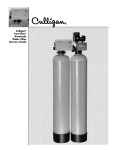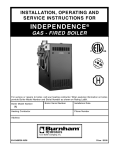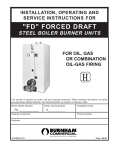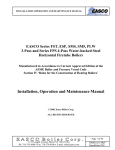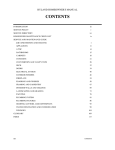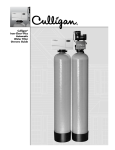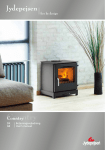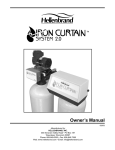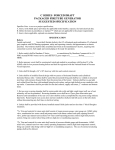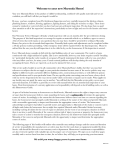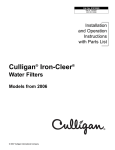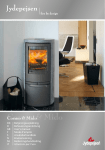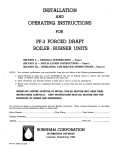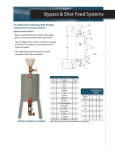Download Burnham C Series Installation Operating Instructions
Transcript
INSTALLATION AND OPERATING INSTRUCTIONS FOR BURNHAM COMMERCIAL FIRETUBE BOILERS Commercial Boilers This manual must only be used by a qualified heating installer/service technician. BEFORE installing, read all instructions in this manual and all other information shipped with the boiler. Post all instructions and manuals near the boiler for reference by service personnel. Perform steps in the order given. Failure to comply could result in severe personal injury, death or substantial property damage. For service and repairs to the heating plant, call your local representatives. When seeking information on the boiler, provide series and size designation shown on rating plate. Boiler Number __________________ Type Firing________________ Type System _________ Project______________________________________________________________ Address_________________________________________________ Phone No._____________ 1 IMPORTANT INFORMATION READ and save these instructions for reference All boilers must be installed in accordance with National, State and Local Plumbing, Heating and Electrical Codes and the regulations of the serving utilities. These Codes and Regulations may differ from this instruction manual. Authorities having jurisdiction should be consulted before installations are made. In all cases, reference should be made to the following Standards: USA BOILERS A. Current Edition of American National Standard ANSI/NFPA 31, “Installation of Oil Burning Equipment”, for recommended installation practices. B. Current Edition of National Fuel Gas Code, NFPA 54/ANSI Z223.1. C. Current Edition of American National Standard ANSI/NFPA 211, “Chimneys, Fireplaces, Vents, and Solid Fuel Burning Appliances”, for venting requirements. D. Current Edition of American Society of Mechanical Engineers ASME CSD-1, “Controls and Safety Devices for Automatically Fired Boilers”, for assembly and operations of controls and safety devices. E. All wiring on boilers installed in the USA shall be made in accordance with the National Electrical Code and/or Local Regulations. CANADIAN BOILERS A. Current Edition of Canadian Standards Association CSA B139, “Installation Code for Oil Burning Equipment”, for recommended Installation Practices. B. The equipment shall be installed in accordance with the current Installation Code for Gas Burning Appliances and Equipment, CSA B149, and applicable Provincial Regulations for the class; which should be carefully followed in all cases. Authorities having jurisdiction should be consulted before installations are made. C. All wiring on boilers installed in Canada shall be made in accordance with the Canadian Electrical Code and/or Local Regulations. Hazard definitions The following defined terms are used throughout this manual to bring attention to the presence of hazards of various risk levels or to important information concerning the life of the product. Indicates an imminently hazardous situation which, if not avoided, will result in death, serious injury or substantial property damage. Indicates a potentially hazardous situation which, if not avoided, may result in moderate or minor injury or property damage. Indicates a potentially hazardous situation which, if not avoided, could result in death, serious injury or substantial property damage. Indicates special instructions on installation, operation, or maintenance which are important but not related to personal injury hazards. 2 This boiler has a limited warranty, a copy of which is printed on the back of this manual. It is the responsibility of the installing contractor to see that all controls are correctly installed and are operating properly when the installation is complete. The warranty for this boiler is valid only if the boiler has been installed, maintained and operated in accordance with these instructions. DO NOT store or use gasoline or other flammable vapors or liquids in the vicinity of this or any other appliance. If you smell gas or fuel oil vapors, do not try to operate the burner/boiler system. Do not touch any electrical switch or use any phone in the building. Immediately call the gas or oil supplier from a remotely located phone. Burner/boiler systems produce steam or hot water in a pressurized vessel by mixing extremely flammable gaseous, liquid or solid fuels with air to produce combustion and very hot products of combustion. Explosions, fires severe personal injury, death and/or property damage will result from improper, careless or inadequate installation, operation or maintenance of fuel-burning and boiler equipment. Improper installation, adjustment, alteration, service or maintenance can cause property damage, personal injury or loss of life. Failure to follow all instructions in the proper order can cause personal injury or death. Read and understand all instructions, including all those contained in component manufacturers manuals which are provided with the appliance before installing, starting-up, operating, maintaining or servicing this appliance. Keep this manual and literature in legible condition and posted near appliance for reference by owner and service technician. Keep boiler area clear and free from combustible materials, gasoline and other flammable vapors and liquids. This boiler requires regular maintenance and service to operate safely. Follow the instructions contained in this manual. Installation, maintenance, and service must be performed only by an experienced, skilled and knowledgeable installer or service agency. All heating systems should be designed by competent contractors and only persons knowledgeable in the layout and installation of heating systems should attempt installation of any boiler. It is the responsibility of the installing contractor to see that all controls are correctly installed and are operating properly when the installation is completed. Installation is not complete unless a pressure relief valve is installed. This boiler is NOT suitable for installation on combustible flooring. Do not tamper with or alter the boiler or controls. Retain your contractor or a competent serviceman to assure that the unit is properly adjusted and maintained. Clean boiler at least once a year - preferably at the start of the heating season to remove soot and scale. The inside of the combustion chamber should also be cleaned and inspected at the same time. Have Burner and Controls checked at least once a year or as may be necessitated. Do not operate unit with jumpered or absent controls or safety devices. Do not operate unit if any control, switch, component, or device has been subject to water. 3 Appliance materials of construction, products of combustion and the fuel contain alumina, silica, heavy metals, carbon monoxide, nitrogen oxides, aldehydes and/or other toxic or harmful substances which can cause death or serious injury and which are known to the state of California to cause cancer, birth defects and other reproductive harm. Always use proper safety clothing, respirators and equipment when servicing or working nearby the appliance. This boiler contains very hot water under high pressure. Do not unscrew any pipe fittings nor attempt to disconnect any components of this boiler without positively assuring the water is cool and has no pressure. Always wear protective clothing and equipment when installing, starting up or servicing this boiler to prevent scald injuries. Do not rely on the pressure and temperature gauges to determine the temperature and pressure of the boiler. This boiler contains components which become very hot when the boiler is operating. Do not touch any components unless they are cool. This appliance must be properly vented and connected to an approved vent system in good condition. Do not operate boiler with the absence of an approved vent system. This boiler needs fresh air for safe operation and must be installed so there are provisions for adequate combustion and ventilation air. The interior of the venting and air intake systems must be inspected and cleaned before the start of the heating season and should be inspected periodically throughout the heating season for any obstructions. Clean and unobstructed venting and air intake systems are necessary to allow noxious fumes that could cause injury or loss of life to vent safely and will contribute toward maintaining the boiler’s efficiency. This boiler is supplied with controls which may cause the boiler to shut down and not re-start without service. If damage due to frozen pipes is a possibility, the heating system should not be left unattended in cold weather; or appropriate safeguards and alarms should be installed on the heating system to prevent damage if the boiler is inoperative. This boiler is designed to burn No. 2 fuel oil, natural and/or LP gas only. Do not use gasoline, crankcase drainings, or any oil containing gasoline. Never burn garbage or paper in this boiler. Do not convert to any solid fuel (i.e. wood, coal). All flammable debris, rags, paper, wood scraps, etc., should be kept clear of the boiler at all times. Keep the boiler area clean and free of fire hazards. Always keep the oil supply valve shut off if the burner is shut down for an extended period of time. Probe and float type low water cutoff devices require annual inspection and maintenance. Refer to instructions in Section IV for inspection and cleaning instructions. Burner/boiler system, as used throughout this manual, shall mean all mechanical and/or electrical equipment including the boiler, burner, pumps, compressors, feed water systems and all associated piping, electrical and control systems used and maintained in the boiler room. 4 TABLE OF CONTENTS SECTION I General information Introduction....................................................................................................................................... 6 Setting the Unit................................................................................................................................. 6 Air Supply/Venting............................................................................................................................ 7 SECTION II Installation Instructions Boiler Piping..................................................................................................................................... 8 Tankless Heater Piping..................................................................................................................... 8 Flow Regulation................................................................................................................................ 8 Hot Water Tempering........................................................................................................................ 9 Heater Flushing................................................................................................................................ 9 Hard Water....................................................................................................................................... 9 Boiler Installation.............................................................................................................................. 10-13 SECTION III Operating Instructions Filling System................................................................................................................................... 14 Adjusting Burner............................................................................................................................... 14 Testing Controls................................................................................................................................ 14 Initial Cleaning, Steam Boilers......................................................................................................... 15 Initial Cleaning, Water Boilers.......................................................................................................... 15 Water Boiler Operation..................................................................................................................... 15-16 Boiler Water Treatment..................................................................................................................... 16 pH or Alkalinity Test.......................................................................................................................... 16 Warnings about Frequent Water Addition......................................................................................... 16 SECTION IV Service Instructions Boiler Shutdown and Cool Down Procedures.................................................................................. 17 Cleaning Boiler Heating Surfaces.................................................................................................... 17-18 Maintenance of Low Water Cutoff Devices...................................................................................... 18 Checking Burner & Controls............................................................................................................. 18 Lubrication........................................................................................................................................ 18 Checking Safety Valve...................................................................................................................... 18 Attention to Boiler while not in Operation......................................................................................... 18-19 Ordering Repair Parts...................................................................................................................... 19 Periodic Testing Recommended Check List..................................................................................... 20-21 WARRANTY......................................................................................................................Back Cover 5 SECTION I — GENERAL INFORMATION INTRODUCTION 1. Refer to burner manufacturer’s installation manual provided for proper venting of the gas train components that require atmospheric pressure to balance a diaphragm. 2. All cover plates, enclosures and guards must be in place at all times, except during maintenance and service. 3. Insulate all steam and hot water piping, fittings and connections and all other hot components and equipment from personnel contact.. 4. Assure all pipes, fittings, electrical controls and all other associated burner/boiler equipment is of proper design and construction for the intended use and provides adequate protection from electrical shock and harmful physical contact to personnel. 5. A leak-tight fuel delivery conduit and control system must be maintained at all times. 6. Products of combustion must be transported from the boiler/burner system to the outdoors in an approved, leak tight, insulated venting system. The boiler room must be positively ventilated to prevent a concentration of products of combustion and a reduction in the amount of oxygen in the air. 7. For optimum performance and serviceability from this unit adhere to the following recommendations: A. Clean firetubes at least once a year, preferably at the end of the heating season to remove soot and scale. Inside surfaces of the furnace, front and rear smokeboxes, and reversing chamber should also be cleaned at the same time. B. Have the burner and controls checked at least once a year or as necessary. C. Retain your contractor or a competent serviceman to assure that the unit is properly adjusted and maintained. 1. GENERAL INFORMATION The boiler is designed specifically for forced draft firing, is available with oil, gas or combination gas/oil burners, and operates with a combustion efficiency of over 80%. This manual gives the necessary information for the proper installation, operation, maintenance and service of units. For special installation problems, contact Burnham Commercial, P.O. Box 3939 Lancaster, PA 17604, Phone: 888-791-3790. 6 2. INSPECT SHIPMENT carefully for any signs of damage. A. All Equipment is carefully manufactured, inspected and packed. Our responsibility ceases upon delivery of boiler to the carrier in good condition. B. Any Claims for damage or shortage in shipment must be filed immediately against the carrier by the consignee. No claims for variances from, or shortage in, orders will be allowed by the manufacturer unless presented within sixty (60) days after receipt of goods. 3. SETTING THE UNIT Most boilers are equipped with lifting lugs to be used in maneuvering the boiler into position. On large boilers, where four lifting lugs are supplied, all four lugs should be used when lifting the boiler. Scotch boilers can also be rolled into position using roller skids under the leg supports, pipe rollers may cause damage. The unit should be located in the boiler room so as to provide ease of venting and adequate clearance for maintenance, serviceability and installation of piping. The tube pull space listed in the Burnham Commercial product catalog must be provided at the front of the boiler. The coil pull space must be maintained at the front of units equipped with tankless coils. Floor construction should have adequate load bearing characteristics to bear the weight of the boiler filled with water. A boiler foundation is recommended if the boiler room floor is weak, uneven or if a water condition exists. These boilers are not for installation on combustible flooring. If desiccant package was ordered, be sure to remove from the boiler furnace using the rear access, and from the waterside using the manhole cover. 4. CHIMNEY OR VENT On installations where a natural draft stack is used, causing high breeching drafts, the boiler locking blade damper (on boilers equipped with one) may require adjusting, or one may need to be installed at the boiler breeching. In multiple boiler installations, or in installations where the breeching draft may vary considerably, automatic draft controls in combination with a motorized damper may be required. When considering the stack and breeching, the design should take into account that the boiler/burner combination will work best when the pressure at the boiler flue outlet is in the range of + or - 1/10 inch WC. 5. AIR SUPPLY A sufficient air supply must be maintained at all times to the boiler room for proper performance of the unit. A permanent opening or duct should be provided so that the boiler input will not exceed 4,000 Btuh/in2 of free area. Example: Firing Rate (Gas) = 528 MBH 528,000 BTUH = 132 In2 Free Area 4,000 BTUH/In2 Follow local building codes if they exceed these minimum requirements. THIMBLE SMOKEPIPE - DO NOT REDUCE BELOW SIZE OF COLLAR ON REAR SMOKEBOX FRONT OF BOILER FIGURE 1 TYPICAL ARRANGEMENT FOR STUB VENT TS-71-129-B 7 SECTION II — INSTALLATION INSTRUCTIONS 1. BOILER PIPING Attach supply and return piping lines and insert plugs and bushings in connections as required. Supply and return piping headers are detailed in Figure 2. It is important to comply with the minimum piping requirements in order to ensure maximum performance and reliability on steam boilers, particular attention should be given to the construction of the supply header. The nominal temperature differential between supply and return water recommended for Burnham firetube water boilers is 20°F. As a precaution against thermal shock, this differential should never exceed 40°F. When differentials in excess of 30°F are anticipated on firebox boilers, the return water should enter the boiler at the top fitting (normally the supply) and the supply water should leave the boiler through the bottom fitting (normally the return). This flow pattern directs the return water over the relatively cool third pass rather than directly against the rear of the furnace. The boiler should not be operated for any length of time at a temperature setting that allows the formation of condensation in the tubes or smokebox. This generally dictates a minimum setting of approximately 140°F on the low limit on systems with a 20°F system differential. On cold start up, condensation can be expected until the boiler warms up. If formation of condensate persists, the low limit should be adjusted upward until condensate no longer forms. Water boilers and low pressure steam boilers must have a set LFH at 120° minimum to avoid condensation. High pressure steam should have a minimum LFH temperature of 180°F. B. If temperature differentials approach 40°F, to help prevent temperature fluctuations and insure proper circulation through the boiler, a recirculation loop as shown in Figure 10 should be considered. The recirculation flow should be at least 1/2 GPM/BHP at all times when the boiler is online for operation. 3. TANKLESS HEATER Install an automatic mixing valve at the tankless heater outlet to avoid risk of burns or scalding due to excessively hot water at the fixtures. Adjust and maintain the mixing valve in accordance with the manufacturer’s instructions. A.If boiler is ordered with tankless heater, connect tankless heater piping as shown in Figure 2. B. The following guidelines should be followed when piping the tankless heaters: 4. FLOW REGULATION If flow through the heater is greater than its rating, the supply of adequate hot water may not be able to keep up with the demand. For this reason a flow regulator matching the heater rating should be installed in the cold water line to the heater. The flow regulator should preferably be located below the inlet so it's not subjected to excess temperatures that may occur during “off” periods when it is possible for the heat to be conducted back through the supply line. The flow regulator also limits the flow of supply water regardless of inlet pressure variations in the range of 20 to 120 psi. 2. RECOMMENDED WATER BOILER RECIRCULATION LOOP The following guidelines relating to system water temperature fluctuation and flow through the boiler must be observed. A. It is important to operate your boiler in such a manner as to prevent temperature fluctuation of more then 40°F at any time. Rapid temperature changes within the boiler can create stresses in the boiler metal. These stresses can cause damage to the boiler by loosening tubes, or in more severe instances can crack tube sheet ligaments,furnaces, or waterlegs. 8 FIGURE 2 SCHEMATIC TANKLESS HEATER PIPING 5. TEMPERING OF HOT WATER Installation of an automatic mixing valve will lengthen the delivery of the available hot water by mixing some cold water with the hot. This prevents excessive and possibly scalding hot water. Higher temperature hot water is possible by piping the hot water from the heater prior to entering the mixing valve. The mixing valve should be “trapped” by installing it below the cold water inlet to heater to prevent lime formation in the valve. 6. FLUSHING THE BOILER All water contains some sediment which settles on the inside of the coil. Consequently, the heater should be periodically backwashed. This is accomplished by installing hose bibs as illustrated and allowing water at city pressure to run into hosebib A, through the heater, and out hosebib B until the discharge is clear. The tees in which the hosebibs are located should be the same size as heater connections to minimize pressure drop. 7. HARD WATER May be applicable to some city and particularly well water. Have your water analyzed by a qualified water treatment specialist to determine if a water softener, conditioner or filtration is required. Treated water will ensure longer tankless heater life and performance and is also beneficial to all the piping and fixtures in the building. 9 INSTALLATION INSTRUCTIONS FIGURE 3 FIGURE 4 10 TS-71-131-D TS-71-130-D INSTALLATION INSTRUCTIONS FIGURE 5 TS-71-124-D PREFERRED HARTFORD RETURN CONNECTION GRAVITY RETURN ALTERNATE HARTFORD RETURN CONNECTION GRAVITY RETURN FIGURE 6 TS-71-157-C 11 INSTALLATION INSTRUCTIONS FIGURE 7 12 TS-71-127-B 13 FIGURE 8 INSTALLATION INSTRUCTIONS TS-71-174-D SECTION III — OPERATING INSTRUCTIONS 1. Always inspect installation before starting burner. 2. Fill heating system with water. Any time that raw water is introduced to the boiler it must be heated to at least 180ºF immediately to dissipate the dissolved gases which can otherwise cause internal corrosion to the boiler. A.Steam Boilers Fill boiler to normal water line. Water should be visible in the gauge glass. After boiler is in operation, make up water should be added slowly to maintain the water level. B. Hot Water Boilers In a hot water heating system, the boiler and the entire system (other than the tank) must be full of water for satisfactory operation. Water should be added to the system until the boiler pressure gauge registers normal system design operating pressure. To ensure that the system is full, water should come out of all air vents when opened. ON A HOT WATER SYSTEM THE PRESSURE MUST NOT EXCEED 30 POUNDS UNLESS THE BOILER IS ESPECIALLY DESIGNED FOR A HIGHER MAXIMUM WORKING PRESSURE. IF A BOILER PRESSURE EXCEEDS PRESSURE SETTING OF SAFETY RELIEF VALVE, VALVE WILL RELIEVE IMMEDIATELY, BUT CAUSE OF RELIEF MUST BE INVESTIGATED AND CORRECTED. EXCESS PRESSURE IS DANGEROUS, IN ADDITION, COULD CAUSE DAMAGE TO HEATING SYSTEM, PERSONAL INJURY OR SERIOUS PROPERTY DAMAGE. DO NOT draw water from the boiler while in use. When adding water while boiler is in operation, do not open the supply valve fully, but add water slowly. D. Turn boiler on and verify that fuel valves are closed during the burner pre-purge cycle. Turn boiler off and disconnect power. E. Adjust burner according to the burner manufacturer's specifications. Target CO2 level is 13% for optimum efficiency, but a range of 12.5 - 13.0% is acceptable. 4. TEST CONTROLS Before installation of the boiler is considered complete the operation of the boiler controls should be checked, particularly the low water cutoff and the high limit control. A. Check Operating Control Raise and lower operating control setting as required to start and stop burner. B. Warning Check High Limit Control Jumper Operating Control Terminals. Allow Burner to operate until shut down by limit. Installation is not considered complete until this check has been made. REMOVE JUMPER. C. Check Low Water Cut-Off control with water level at normal waterline. Raise operating control setting to allow burner to operate. Open boiler drain to allow water level to drop until burner operation is shut down by low water cutoff. DO NOT ALLOW THE BOILER TO OPERATE BELOW THE MINIMUM PERMISSIBLE WATER LEVEL AS INDICATED ON THE BOILER. Close boiler drain and refill to normal water line. Unless boiler is equipped with a manual reset low water cutoff, burner should automatically restart during fill. Reset operating control. 3.BURNER A. Check wiring of all fuel valves. Verify that wiring is correct according to the factory supplied wiring diagram. B. Leave all manual fuel valves closed. This includes manual shutoff valves supplied with the boiler and facility installed valves at the boiler site. C. Perform all burner pre-startup checks according to the burner manufacturer's specifications. Refer to the burner manufacturer's installation manual furnished with the boiler. 14 PROBE AND FLOAT TYPE LOW WATER CUT-OFF DEVICES REQUIRE ANNUAL INSPECTION AND MAINTENANCE. Refer to Service Instructions, Section IV for proper cleaning instructions. D. Check Operating Control on boiler equipped with a tankless heater. With burner off, draw hot water until burner starts, then turn off hot water and check burner shut down. 5. CLEANING A NEW STEAM BOILER 6. CLEANING A WATER BOILER Oil, grease & sediments which accumulate in a new boiler and piping must be removed from the system in order to prevent an unsteady water line and carryover of the water into the supply main above the boiler. Operate the boiler with steam in the entire system for a few days allowing the condensate to return to the boiler. If the condensate can temporarily be wasted, operate the boiler only for the length of time it takes for condensate to run clear. If the latter cannot be achieved or if the condensate s returned to the boiler, boil out the boiler using the SURFACE BLOWOFF connection on the boilers so equipped. The oil and grease which accumulate in a new hot water boiler can be washed out in the following manner. A. Remove safety relief valve using extreme care to avoid damaging it. Certain state and local codes may restrict the use of some chemicals listed for cleaning and maintaining the boiler. Check with local authorities before proceeding with the use of any chemicals. A. Drain boiler until water is just visible in gauge glass. Run temporary pipe line from the surface blow-off to an open drain or some other location where hot water may be discharged safely. B. Drain about 5 gallons of hot water from boiler into a container and dissolve into it 1 pound of caustic soda and one pound of trisodium phosphate for each 50 gallons of boiler water. Do not install valve in this line. C. Add solution through exposed tapping, and reinstall safety valve. Certain state and local codes may restrict the use of some chemicals listed for cleaning and maintaining the boiler. Check with local authorities before proceeding with the use of any chemicals. D. Fill the entire system with water. E. Start firing the boiler F. Circulate the water though the entire system. B. Drain about 5 gallons of hot water from boiler into a container and dissolve into it 1 pound of caustic soda and one pound of trisodium phosphate for each 50 gallons of boiler water. Additional containers may be required to dissolve sufficient chemicals for large models. Remove safety valve and add solution to boiler water through exposed tapping. G. Vent the system, including the radiation. L. When the boiler has cooled down to 120°F or less, remove plugs from all available returns and wash the water side of the boiler as thoroughly as possible, using a high-pressure water stream. Use extreme care in handling these chemicals. Caustic soda is harmful to skin, clothing and eyes. Do not permit the dry material or the concentrated solution to come into contact with the skin or clothing. C. Close all valves leading to and from the system to isolate the cleaning solution from the system. D. Start Burner and operate sufficiently to boil the water without producing steam pressure. Boil for about 5 hours. Open boiler feed pipe sufficiently to permit a steady trickle of water from the surface blowoff pipe. Continue this slow boiling and trickle of overflow for several hours until the water coming from the overflow is clear. E. Stop burner and drain boiler in a manner and location that hot water can be discharged safety. F. When the boiler has cooled to 120°F or less refill boiler to normal water line. If water in gauge glass does not appear to be clear, repeat steps A thru E, boiling out the boiler for a longer time. G. Remove temporary piping, plug tapping and/or reinstall safety valve. Boil to bring water temperature to 180ºF promptly in order to drive off any dissolved gases in the fresh water. H. Allow boiler water to reach operating temperature, if possible. I. Continue to circulate the water for a few hours. J. Stop firing the boiler K. Drain the system in a manner and to a location that hot water can be discharged safely. M. Refill the system with fresh water, and bring water temperature to 180°F promptly in order to drive off any dissolved gases. 7. WATER BOILER OPERATION The following guidelines relating to system water temperature fluctuation and flow through boiler must be observed. A. It is important to operate your boiler in such a manner as to prevent temperature fluctuation of more than 40°F at any time. Rapid temperature changes within the boiler can create stresses in the boiler metal. These stresses can cause damage to the boiler by loosening tubes, or in more severe instances can crack tube sheet ligaments, furnaces, or waterlegs. B. It is equally important to insure that there is circulation through the boiler of at least 1/2 GPM/ BHP at all times when the boiler is firing. 15 8. BOILER WATER TREATMENT Boiler water treatment will help maximize the effectiveness and prolong the life of pressure vessels. The general objectives of boiler water treatment are: A. Remove corrosive gases from feedwater and boiler water. and eventually cracks. The presence of free oxygen in the boiler creates a corrosive atmosphere which, if the concentration becomes high enough, can corrode the cast iron through from the waterside. Since neither of these failure types are the result of a casting defect the warranty does not apply. Clearly it is in everyone’s best interest to prevent this type of failure. The maintenance of system integrity is the best method to achieve less makeup water. B. Prevent sludge and scale deposits on the water side heating surfaces. C. Prevent foaming and carryover. Oxygen contamination of the boiler water will cause corrosion of iron and steel boiler components, and can lead to boiler failure. Burnham’s standard warranty does not cover problems caused by oxygen contamination of boiler water or scale (lime) build-up caused by frequent water addition or by improper water chemistry as shown below. Consult with a local water treatment company regularly engaged in the treatment of boiler water for advice in maintaining the proper feedwater, boiler water, and condensate chemistry. Certain state and local codes may restrict the use of some chemicals listed for cleaning and maintaining the boiler. Check with local authorities before proceeding with the use of any chemicals. 9. MAKE PH OR ALKALINITY TEST After boiler and system have been cleaned and refilled as previously described, test the pH of the water in the system. This can easily be done by drawing a small sample of boiler water and testing with hydrion paper which is used in the same manner as litmus paper, except it gives exact readings. A small color chart on the side of the hydrion dispenser gives the reading in pH. Hydrion paper is inexpensive and obtainable from any chemical supply house or through your local druggist. The pH should be higher than 8.3 but lower than 10.5. Add some washout chemical (caustic soda), if necessary, to bring the pH within the specified range. Minimum Water Quality Requirements pH - 8.3 - 10.5 TDS - 3500 ppm Total alkalinity ppm as CaCO3 - 1200 Total copper ppm - .05 Oily matter ppm -1 total harness ppm -3 Chlorides - < 50 ppm There are many possible causes of oxygen contamination such as: a. Addition of excessive make-up water as a result of system leaks. b. Absorption through open tanks and fittings. c. Oxygen permeable materials in the distribution system. d. Suction at pump and valve seals. In order to ensure long product life, oxygen sources should be eliminated. This can be accomplished by taking the following measures: a. Repairing system leaks to eliminate the need for addition of make-up water. b. Eliminating open tanks from the system. c. Eliminating and/or repairing fittings which allow oxygen absorption. d. Use of non-permeable materials in the distribution system. e. Isolating the boiler from the system water by installing a heat exchanger. 10. FREQUENT WATER ADDITION If, during normal operation, it is necessary to add water more frequently than once a month, consult a qualified service technician to check your system for leaks. A leaky system will increase the volume of make-up water supplied to the boiler which can significantly shorten the life of the boiler. Entrained in make-up water are dissolved minerals and oxygen. When the fresh, cool make-up water is heated in the boiler the minerals fall out as sediment and the oxygen escapes as a gas. Both can result in reduced boiler life. The accumulation of sediment can eventually isolate the water from contacting the cast iron. When this happens the cast iron in that area gets extremely hot 16 SECTION IV — SERVICE INSTRUCTIONS See item 10 under Operating Instruction if it becomes necessary to add water to the boiler more frequently than once a month. 1. GENERAL G. When boiler and water are below 120°F, shut off power to the unit and lock out the circuit breakers. Inspection should be conducted annually. Service as frequently as specified in paragraphs below. Before service or maintenance is performed complete boiler shutdown/cooldown procedure. 2. BOILER SHUT DOWN AND COOLDOWN PROCEDURE NOTE: This procedure is generally required in preparation for corrective or preventative maintenance in the unit. This procedure must be supervised by an individual who is thoroughly qualified in operation and maintenance of the equipment at hand. This is written with Steam Boilers in mind, but the principles are applicable to Hot Water Boilers as well. A. Decrease plant load as much as possible. B. Turn boiler switch off. If control power from burner is used to support accessories, leave on until boiler system has cooled down. H.If required, open front and rear doors for observation of fireside surfaces. I. Drain boiler down as far as required. (Usually completely.) Make sure the vent valve on the top of the boiler remains open. Open and lock the float control low water cutoff drain valves. These will serve as additional vents. J. Shut and lock the boiler feed valves, and any blowdown valves that can be affected by other boilers in the same facility (i.e., bottom blow down valves can tie into a common blowdown separator in a multiple boiler installation). K. If necessary to remove handhole and/or manhole plates for water side inspection or maintenance, use extreme caution. Loosen the nuts securing the arch enough to allow the plate to drop approximately 1/8 inch when tapped loose with a mallet. Once again, ensure the pressure in the boiler is “0” before loosening the plate. Remove the plate the remainder of the way. Wear gloves and eye protection at all times. C. Shut and lock manual gas and oil valves as applicable. 3. CLEAN THE BOILER HEATING SURFACES AND FLUE D.In single boiler installations, some small steam loads can remain on to assist in a controlled cooldown of the boiler (i.e., deaerator). In multiple boiler installations, shut down the non-return valve and the back up valve. Lock them shut. At least once each year, preferably at the end of the heating season. A. Clean the Vent System Vent system should be checked annually for: E. Allow the boiler feed pump to remain active. As the boiler cools down, the water level is reduced by demand or shrinkage. It is best to be aware of the boiler level at all times. 1.Obstructions. F. When boiler pressure has decreased to 5 to 10 psi on the pressure gauge, open the boiler manual vent valve on the top of the boiler. This is to act as a sentinel against the increase in pressure and to prevent the boiler from going into a vacuum. Lock the valve open. 4. Proper support no sags, particularly in horizontal runs. NOTE: Depending on the size of the boiler, the large mass of heating surfaces that are still hot can cause the boiler water temperature to increase, even if the gauge pressure is “0”. It is better to allow the entire system to cool gradually, never force cool the boiler as damage can also be inflicted due to “thermal shock.” 2. Accumulations of soot. 3. Deterioration of vent pipe or vent accessories due to condensation or other reasons. 5. Tightness of joints. Remove all accumulations of soot with a wire brush and vacuum. Remove all obstructions. Replace deteriorated parts and support properly. Seal all joints. B. Clean the Boiler Heating Surfaces At the end of the heating season, clean boiler heating surfaces thoroughly. Access to boiler firetubes may be gained by removing the front and rear smokeboxes or smokebox doors. Where applicable, remove the turbulators, paying close attention to which tubes have turbulators. 17 Clean firetubes with flue brush and reinstall turbulators. If turbulators are corroded or deteriorated, replacing them will ensure a high level of boiler efficiency. Remove soot and rust and reseal the boiler. 4. MAINTENANCE OF LOW WATER CUTOFF DEVICES 11. Screw the probe into the boiler tapping. 12. Mount the low water cutoff control on the probe. 13. Reconnect the control to probe wiring. 14. Fill the boiler to its normal waterline. 15. Add boiler water treatment compound as needed (see Section III Item 8). 16. Restore electric service to boiler. Probe and float type low water cutoff devices require annual inspection and maintenance. A. Probe Type Low Water Cut Off Although these devices are solid state in design, the probe is exposed to possible contamination in the boiler water. It is important to physically remove the probe from the boiler tapping annually and inspect it for accumulation of scale or sediment. Following these steps inspect, clean and/or replace the probe: 1. Turn off electric service to the boiler. 2. Drain boiler water to a level below the tapping for the probe. 3. Disconnect the wiring connections between the low water cutoff and the probe. 4. Dismount the low water cutoff control from the probe. 5. Unscrew the probe from the boiler tapping. 6. Inspect that portion of the probe that is exposed to the boiler water for scale or sediment buildup. 7. Light deposits may be removed by wiping the probe with a damp cloth. Wiping the probe with a cloth soaked in vinegar will remove more tenacious lime deposits. The most stubborn deposits may be removed from the probe by using diluted amount (3 part of water to 1 part) of phosphoric acid (H2PO4). Exercise caution when handling phosphoric acid and follow the instruction label on its container. 8. Wire brushing of the probe is not recommended. 9. Clean the pipe threads of the probe to remove old, hardened pipe dope and other foreign matter. 10. Apply a moderate amount of good quality pipe dope to the pipe threads on the probe, leaving the first two threads bare. Do not use PTFE (Teflon) tape. 18 17. Fire burner to raise water temperature to above 180°F to drive off free oxygen. BEFORE RETURNING BOILER TO SERVICE: Follow the low water cutoff check out procedure in Section III Item 4 Part C. B. Float Type Low Water Cut-Off During the heating season, if external low water cutoff is on the boiler, the blow off valve should be opened once a month (use greater frequency where conditions warrant), to flush out the sediment chamber so the device will be free to function properly. Low water cutoffs and water feeders should be dismantled annually by qualified personnel, to the extent necessary to insure freedom from obstructions and proper functioning of the working parts. Inspect connecting lines to boiler for accumulation of mud, scale, etc., and clean as required. Examine all visible wiring for brittle or worn insulation and make sure electrical contacts are clean and that they function properly. Give special attention to solder joints on bellows and float when this type of control is used. Check the float for evidence of collapse and check mercury bulb (where applicable) for mercury separation or discoloration. DO NOT ATTEMPT TO REPAIR MECHANISM IN THE FIELD. Complete replacement mechanisms, including necessary gaskets and installation instructions, are available from the manufacturer. 6. CHECK BURNER AND CONTROLS at least once a year. See Item 4 under Operating Instructions for control checks. See Burner Manual for burner tests and adjustments. 7. LUBRICATE BOILER COMPONENTS according to manufacturer’s instructions. Generally, this involves burner and circulator. 8. CHECK SAFETY VALVE at the start of each heating season and once or twice during the season to be sure it is in working condition. To do this, fasten wire or cord to the lever of the valve and pull the lever standing a safe distance away from the valve. 9. ATTENTION TO THE BOILER WHILE NOT IN OPERATION. If a boiler is not used during the winter months, and it is in a place subject to freezing, it must be fully drained to prevent freezing damage. A.Steam Boilers Procedure for taking steam boilers off line at the end of heating season: Drain off boiler water until it runs clear while holding the boiler temperature between 180 and 200ºF. Then refill to top of gauge glass. B. Water Boilers Since a water boiler is a closed system, no draining/refilling should be necessary. C. Note any time raw water is introduced into the boiler it must be immediately heated to 180°F to drive off dissolved gases. If water treatment is used, sufficient water treatment compound should be added to condition the make-up water. 10. REPAIR PARTS Give boilers series and model number when ordering repair parts. All repair parts can be ordered through your local representative or call us at 888-7913790. 19 PERIODIC TESTING RECOMMENDED CHECK LIST ITEM FREQUENCY ACCOMPLISHED BY REMARKS Gauges, monitors, and Daily Operator indicators Make visual inspection and record readings in log Instrument and equipment Daily Operator settings Make visual check against recommended specifications Firing rate control Verify factory settings Verify factory settings Check with combustion test Weekly Semi-annually Annually Operator Service Technician Service Technician Igniter Weekly Operator Fuel Valves Pilot and Main Weekly Operator Pilot and Main Annually Service Technician Gas or Oil Make visual inspection, check flame signal strength, if on display (see "combustion safety controls) Open limit switch - make aural and visual check - check valve position indicators and check fuel meters if so fitted Perform leakage tests - refer to burner instructions Combustion Safety Controls Flame Failure Weekly Operator If flame display installed, read and log; for both pilot and main flames, notify service organization if readings are very high, very low or fluctuating; refer to burner instructions. Flame Signal Strength Weekly Operator If flame display installed, read and log; for both pilot and main flames, notify service organization if readings are very high, very low, or fluctuating; refer to burner instructions. Pilot Turndown Tests As required/ Service Technician Annually Required after any adjustments to flame scanner mount or pilot burner; verify annually - refer to burner instructions Low Water Fuel Daily/Weekly Operator Cutoff and Alarm Semi-annually Operator Refer to control instructions Perform a slow drain test in accordance with ASME Boiler and Pressure Vessel Code Section VI High Limit Safety Control Annually Service Technician Refer to control instructions Operating Control Annually Service Technician Refer to control instructions Air Proving Switch Monthly Operator Refer to burner instructions 20 PERIODIC TESTING RECOMMENDED CHECK LIST ITEM Atomizing Air/Steam FREQUENCY Annually ACCOMPLISHED BY REMARKS Service Technician Refer to burner instructions High and Low Gas Monthly Operator Pressure Interlocks Refer to burner instructions High and Low Oil Pressure Interlocks Monthly Operator Refer to burner instructions High and Low Oil Temperature Interlocks Monthly Operator Refer to burner instructions Fuel Valve Interlock Switch Annually Service Technician Refer to burner instruction Purge Switch Annually Service Technician Refer to burner instructions Burner Position Interlock Annually Service Technician Refer to burner instructions Low Fire Start Interlock Annually Service Technician Refer to burner instructions Automatic Changeover Control (dual fuel) At Least Annually Service Technician Under supervision of gas utility Safety Valves As required Operator In accordance with procedure in Section VI, ASME Boiler and Pressure Vessel Code, Recommended Rules for Care and Operation of Heating Boilers or Section VII for power boilers. Inspect Burner Components Semi-annually Refer to burner instructions Service Technician 21 22 23 Commercial Boilers LIMITED WARRANTY LIMITED WARRANTY Subject to the terms and conditions herein, Seller warrants to the original owner at the original installation site that products manufactured by Seller (“Products”) comply, at the time of manufacture, with recognized hydronics industry regulatory agency standards and requirements therein effect and will be free from defects in materials and workmanship for a period of 12 months after the date of start-up or 18 months after the date of shipment, whichever shall be less (the “Warranty Period”) REMEDY A. The sole remedy for breach of this warranty is expressly limited to the repair or replacement of any part found to be defective under conditions of normal use within the Warranty Period. Installation is not included. B. Warranty The owner must notify the original installer of the Product and Seller (Attention: Burnham Commercial, PO Box 3939, Lancaster, PA 17604) in writing, within the Warranty Period, providing a detailed description of all claimed defects. Transportation to a factory or other designated facility for repairs of any products or items alleged defective shall, in all events, be the responsibility and at the cost of the owner. EXCLUSIONS Seller shall have no liability for: A. Incidental, special or consequential damages, such as loss of the use of products, facilities or production, inconvenience, loss of time or labor expense involved in the repairing or replacing of the alleged defective Product. B. F. Any failure resulting from misuse, modification, not authorized by Seller in writing, improper installation or lack of proper maintenance. G. Equipment furnished by the owner, either mounted or unmounted, or when contracted for by owner to be installed or handled. Seller’s liability under this warranty shall not in any case exceed the amount paid for the Product found defective. THIRD-PARTY WARRANTIES For goods or components not manufactured by Seller, the warranty obligations of Seller shall, in all respects, conform and be limited to the warranty actually extended to Seller by its vendors. SEVERABILITY To the extent that any provisions of this warranty would be void or prohibited under applicable law, such provisions shall be limited in effect to the minimum extent necessary to render the remaining provisions hereof enforceable. NO OTHER WARRANTIES Seller makes no implied warranty of merchantability or fitness for a particular purpose, or other warranties with respect to any products or services except as expressly set forth in this limited warranty. The performance of any Product under conditions varying materially from those under such Products is usually tested under industry standards as of the shipment time. C. Any damage to the Product due to abrasion, erosion, corrosion, deterioration, abnormal temperatures or the influence of foreign matter or energy. D. The design or operation of owner’s plant or equipment or of any facility or system of which any Product may be made a part. 24 E. The suitability of any Product for any particular application. Form No. 81460393R3 - 10/14 Printed in the U.S.A. Lancaster, PA 17601 Phone: 888-791-3790 www.burnhamcommercial.com

























